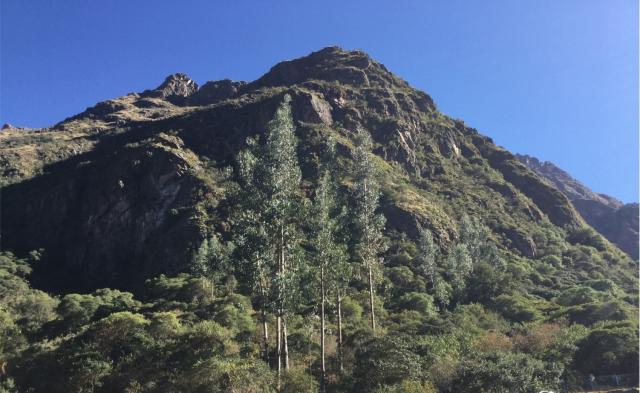Home > International Partnerships > Collaborative Research > Establishment of Integrated Forest Management System for Conservation of Mountain Forest Ecosystems in the Andean - Amazon
Update:May 1, 2025
Main content starts here.
Establishment of Integrated Forest Management System for Conservation of Mountain Forest Ecosystems in the Andean-Amazon

1. Partners
La Molina National Agrarian University (UNALM), Peru
Forest and Wildlife National Service (SERFOR), Peru
Chiba University, Japan
Kyushu University, Japan
Japan Forest Technology Association (JAFTA)
2. Research Period
FY 2019-2025 Science and Technology Research Partnership for Sustainable Development (SATREPS) (JST-JICA)
3. Lead Researcher
HIRATA, Yasumasa (Department of Forest Management)
4. Background
In recent years, forest fires have been increasing in both frequency and scale due to extreme dryness, which is believed to be a result of climate change. In the Amazon, in particular, uncontrolled burning for land conversion has caused large-scale forest fires, and international discussion on how to solve this problem is progressing. Furthermore, there have been reports that forest residues left in degraded forests are contributing to larger fires. Forest fires not only release forest carbon into the atmosphere but also affect forest soils and soil moisture. The process by which disturbed forests recover and self-heal is unclear.
In the Andes, where deforestation and forest degradation are increasing, local residents have been actively planting eucalyptus trees to meet the demand for wood resources. Recently, people living in the mountainous areas have become suspicious that, in addition to the aridification resulting from climate change, eucalyptus plantations are using a considerable amount of water resources, which may be reducing the supply of water for agricultural land. To optimize the allocation of water resources to various land uses, it is necessary to estimate the amount available from the supply and demand of water resources.
5. Research Goal
To develop a forest management system model for local communities to conserve and utilize forest ecosystem services sustainably in the Andean-Amazon.
6. Research Strategy
1) Identify time-series land use change by taking into account the forest carbon stock change and the degree of forest degradation.
2) Develop a technology for the quantitative assessment of deforestation and forest degradation.
3) Develop a method for the assessment of forest recovery processes after fire disturbance.
4) Develop a landscape optimization system with a water resource model.
5) Develop a forest management system model to realize better usage of ecosystem services in consideration of socioeconomic characteristics and science-based scenarios.
6) Apply a forest management system model to enhance sensible decision-making with local communities.
7. Expected Outcomes
A system will be developed to support appropriate forest allocation and forest management to maximize co-benefits from forests through establishing a harmony between local needs, such as the use of wood and water resources by local residents, with global needs, such as the reduction of carbon emissions and the conservation of biodiversity through the control of both deforestation and forest degradation. Workshops will be held to disseminate the forest management system to various stakeholders to enable the developed forest management system to be used by the community.
8. Publications
Wei Yang, Shiping, Yang. Land-cover mapping in the Andean-Amazon area using Sentinel-2 time-series data based on Google Earth Engine, AGU Fall meeting 2021, 2021.12
Koji Tamai. Forest management method for water resource conservation function of forest: Example for determining the location and area of trees cut down. 12th International Conference on Sustainable Development and Planning, 2022.6
Tamotsu Sato, Forest conservation is not just about carbon stocks — perspectives from forest ecology and field research, A Better World, 2022, Volume 8, 47-49.
Wei Yang. Monitoring of Land-Use/Land-Cover Change in the Peruvian Andes-Amazon based on Spatiotemporal Fusion of Multiple Satellite Data、AGU Fall Meeting, 2022.12
Yasumasa Hirata et al., Monitoring natural forests in the Andes-Amazon in three dimensions with multi-satellite sensors, IUFRO 2024 XXVI World Congress, Book of Abstracts:3672, 2024.06.
Yasumasa Hirata et al., Understanding land use change at the landscape level using machine learning for maximizing forest ecosystem services in the Andes, IUFRO 2024 XXVI World Congress, Book of Abstracts:3754, 2024.06.
Yasumasa Hirata et al. Improving Land Use Classification Using Sentinel 2 and GEDI Data in the Andean Region, ForestSAT 2024, Abstract Book:196, 2024.09.
Kazuki Miyamoto et al., Forest degradation assessment in the Andean-Amazon region based on species composition approach, IUFRO 2024 XXVI World Congress, Book of Abstracts:2594, 2024.06.
Miki Toda et al., Is Forest Management Disappearing during the Decentralization Process in Peru?, The 34th Annual Meeting of the Japan Society of Tropical Ecology, 2024.06
Copyright © Forest Research and Management Organization. All rights reserved.
